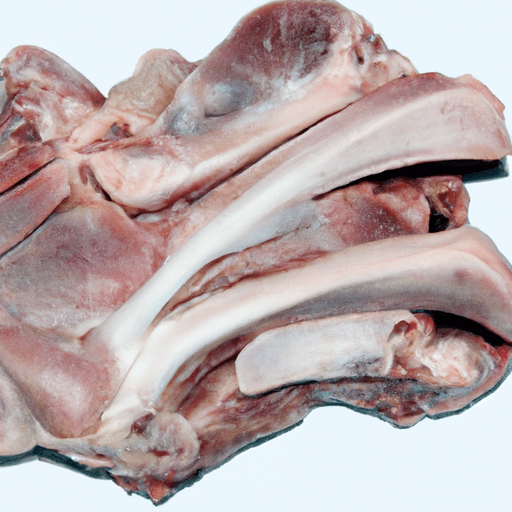Unleashing the Flavor: A Closer Look at Veal Bones
If you’re a passionate foodie with a curiosity for culinary wonders, then veal bones might just be the next ingredient to catch your attention. These delicious bones offer a powerhouse of flavors and have been a staple in kitchens around the world for centuries. In this blog post, we’ll explore the taste, uses, nutritional value, and interesting facts about veal bones. So, let’s dive right in!
Taste Sensations Await
Veal bones, derived from young calves, possess a unique and delicate flavor unlike any other. Their gentle nature provides a milder taste compared to beef bones, making them a versatile ingredient for a variety of dishes. When cooked properly, these bones infuse their essence into broths, soups, stews, and sauces, elevating the depth of flavor to new heights. The result? A culinary experience that tantalizes the taste buds, leaving you craving for more.
Culinary Marvels
Veal bones play a vital role in professional kitchens and home cooking alike, offering a plethora of culinary possibilities. One of the most popular uses for veal bones is in the creation of rich and velvety stocks. The bones, when simmered slowly alongside aromatic vegetables and herbs, release gelatin, collagen, and minerals, imparting a luscious and savory base for a wide range of dishes.
These flavorful stocks form the foundation of classic French sauces, such as demi-glace and velouté. They also serve as a building block for hearty soups, like the renowned Italian staple, ossobuco. The combination of veal bones with tender meat, vegetables, and a splash of white wine creates a symphony of taste that is both comforting and satisfying.
Got a hankering for something crispy? Veal bones can also be roasted to perfection, resulting in delectable treats. Crackling with a delightful crunch, roasted veal bones are often served alongside dipping sauces or as an accompaniment to flavorful spreads. They make for an excellent appetizer, sure to impress guests and ignite conversations when shared.
Nutritional Powerhouse
Apart from their impressive flavor profile, veal bones offer an array of nutritional benefits. They are a rich source of collagen and gelatin, both of which are essential for healthy skin, joints, and bones. These compounds also aid in digestion and promote gut health, making veal bones a valuable addition to any wholesome diet.
Furthermore, veal bones are packed with minerals such as calcium, magnesium, and phosphorus, playing a crucial role in supporting bone strength and overall wellness. Incorporating veal bones into your recipes allows you to reap these nutritional rewards while savoring their delectable taste.
A Journey Through History
Veal bones have an intriguing history that traces back centuries. With roots in French and Italian cuisine, these bones have been cherished by renowned chefs and home cooks alike. Their presence in traditional dishes showcases a deep connection to the culinary heritage and the respect for local ingredients.
Over time, veal bones have transcended borders and become a beloved ingredient in many global cuisines. From the iconic Italian osso buco to the French classic pot-au-feu, these bones have found their way into the hearts and stomachs of food enthusiasts around the world.
Let Your Culinary Adventure Begin
It’s time to unleash your inner chef and embark on a journey with veal bones as your guide. Whether you’re simmering a stock for a comforting soup or roasting them for a crispy delight, these bones never disappoint. Their delicate flavor, versatility, and nutritional value make them an essential ingredient in any kitchen.
So, the next time you’re seeking to elevate your cooking to new heights, don’t hesitate to embrace the wonders of veal bones. Your taste buds will thank you, and your culinary creations will soar to new levels of deliciousness!
Veal Bones
Origin: Veal bones are derived from the skeletons of young calves, typically between 3 to 16 weeks old. Veal is the meat of young calves, usually male dairy calves, which are raised to the prescribed weight for veal production before being processed.
Common Uses: Veal bones are predominantly used in the preparation of stocks, broths, and sauces. They are highly valued for their rich flavor and gelatinous quality. The bones are typically roasted to enhance their flavor before being used in various culinary applications.
Nutritional Benefits: Veal bones have several nutritional benefits. They are a rich source of collagen, a protein that helps promote joint health, improve skin elasticity, and support the growth and repair of tissues. Additionally, veal bones provide essential minerals such as calcium and phosphorus, which contribute to strong bones and teeth.
Unique Properties: One unique property of veal bones is their high gelatin content. As they cook, the collagen in the bones breaks down, resulting in a gelatinous texture that adds body and richness to sauces and stocks.
Historical Significance: The use of veal bones in culinary preparations dates back centuries. Stocks made from veal bones have long been a staple in French cuisine, forming the foundation of many classic sauces, soups, and stews. The slow simmering of veal bones allows for the extraction of rich flavors and essential nutrients, contributing to the complexity and depth of traditional French cuisine.




Use the share button below if you liked it.
It makes me smile, when I see it.